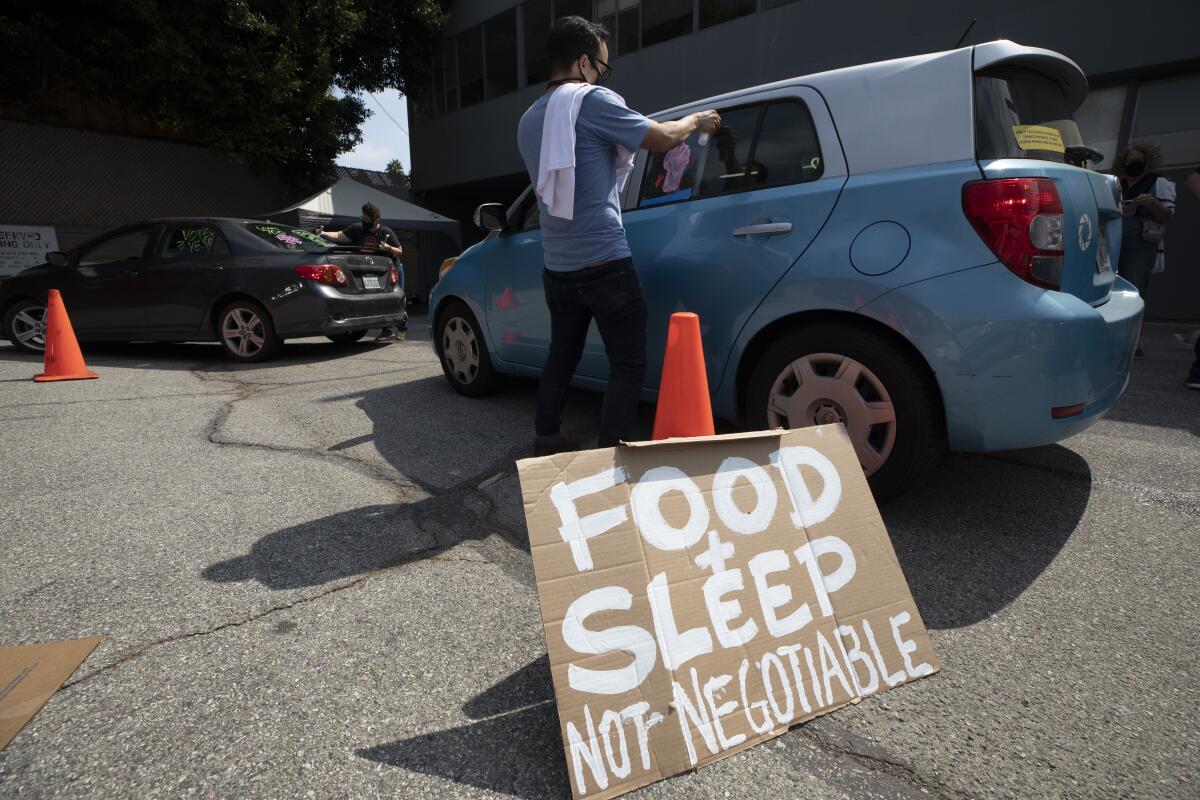Why Hollywood crews are giving mixed reviews on new contract

- Share via
After the union representing Hollywood crews finally reached a deal on a new contract last week, International Alliance of Theatrical Stage Employees President Matthew Loeb proclaimed it “a Hollywood ending” and a sign that “our members stood firm.”
The tentative three-year contract on behalf of 40,000 film and TV workers who belong to IATSE averted what would have been a devastating nationwide strike and the first in the union’s 128-year history.
“This is the best contract since 1996,” said cinematographer and former Local 600 President Steven Poster, referring to when the camera locals merged. “We got everything we asked for.”
Other union members, however, were less than enthusiastic, and even accused their leaders of capitulating to the powerful Hollywood studios.
An Instagram page that over the summer became a forum for crews’ struggles and helped drive a groundswell of support for a historic strike authorization vote was flooded with complaints among frustrated workers when the deal was announced last Saturday.
“They were patting themselves on the back without even talking to us first,” said Kathleen McAuley, a Los Angeles-based film and TV editor member of Local 700 who intends to vote against the contract. “We just held a huge hand. And we just basically folded.”
The deal between the International Alliance of Theatrical Stage Employees and the major studios is a rare display of muscle for the industry’s “below-the-line” production crews.
The sharply differing points of view offer a window into the changing dynamics inside the union that represents camera operators, makeup artist, set decorators, editors, grips and others who work in “below-the-line” Hollywood.
Crew members and labor experts say the fissures reflect a widening divide between younger activist workers, who aren’t shy about making their demands public on social media, and veteran union leaders who have traditionally avoided confrontations with studios — and kept dissidents in line.
“What we’re seeing now is a division between the leadership of the union and rank-and-file members,” said Steve Ross, a history professor at the University of Southern California who specializes in Hollywood labor unions. “From the leadership’s point of view they seem to have a sweet deal here. ... But for the workers ... people are exhausted. What they’re saying is it’s no longer just about money.”
This week, IATSE has been parceling out details of the proposed contract and holding meetings with members to answer questions and explain the highlights.
In order to be ratified, the agreement must be approved by a majority. Although it’s unclear how many will vote against the contract in the coming weeks — the union has not announced when voting begins — IATSE leaders are confident the agreement will be ratified.
“Goals we have been pursuing for decades have been achieved in these negotiations,” Loeb said in an email to The Times. “As of now, the documents between the union and employer are being drafted, so deciding prematurely is a mistake. Read it, discuss it with your leadership and colleagues and get your questions answered.”
Loeb didn’t respond to criticism of how the the contract was communicated to members, but he said he was not surprised by some of the backlash.
“Our members are active and that’s what brings us power,” he said. “Their conditions of employment needed to be addressed and it’s solidarity that drives our ability to do that.”
The proposed contract includes: 3% annual wage hikes (some lowest-paid members will see increases of up to 60%); improvements in conditions and pay on streaming productions by up to 30%; and observance of the Martin Luther King Jr. holiday. It guarantees rest periods of 10 hours between daily shoots and — for the first time — 54 hours on weekends, widely considered a major concession by the studios. Additionally, it increases penalties for companies that don’t provide meal breaks.
Despite the gains, some members have said the proposed contract doesn’t go far enough to reduce long hours, strengthen the union’s health and pension plans and boost wages. Some critics, for example, note that the 3% wage hikes, although in line with other unions, are below the inflation rate of 5.4%.
James Duhon, a Dallas, Texas-based cinematographer, says he intends to vote against the contract. While the guaranteed weekend rest period is welcome, he said the plan leaves open the possibility of 74-hour work weeks.
“Do we really want that? Nope. Hard Pass. Also, for the African American community, Juneteenth is still not on the table for off days and for MLK to be finally recognized in 2021 is upsetting,” said Duhon, who is Black.
L.A.-based makeup artist Cici Andersen shares the concern about 14-hour days and also plans to vote against the deal. “People want a cap on how long can they work you in a day so that you can just shower and do some laundry,” Andersen said.
The COVID-19 pandemic has also fueled some of the tensions within the union, as producers pushed crews to the limit to make up for lost time during shutdowns.
The health crisis also heightened concerns about the state of their healthcare benefits. The Alliance of Motion Picture and Television Producers agreed to cover a nearly $400 million deficit in the health and pension plans but opposed increasing residual payments that fund the plans, a sore point for some members.
McAuley, the film editor, said she is concerned that the health and pension plans are only secured for the term of the contract.
“I didn’t get into the union to have to worry about how our healthcare will be funded every three years,” McAuley said.
Loeb defended the agreement, saying “quality of life issues” were at the top of the union’s priority list.
“The protective terms we negotiated establish a defined weekend with the studios for the first time in the U.S.,” Loeb said. “They incorporate stiff penalties for failing to provide meals and breaks. The improvements are very significant.”
Loeb added that the union’s negotiation committee “determined that a residuals fight would likely result in a protracted dispute. We have funded the benefit plans with no cuts in benefits and no additional costs to the members.”
It was perhaps inevitable that some union members would be disappointed by the agreement. In order to secure a strike authorization vote, IATSE spent weeks mobilizing members for a possible walkout, a campaign that took off at the grassroots level and may have created expectations that union leaders could not meet.
“Right now is a very special moment in the history of the union, where people are paying attention more than ever,” said Andersen. “ “This is a opportunity for leadership to learn from younger people with leadership abilities the same way we have looked to and admired them.”
More to Read
Inside the business of entertainment
The Wide Shot brings you news, analysis and insights on everything from streaming wars to production — and what it all means for the future.
You may occasionally receive promotional content from the Los Angeles Times.












